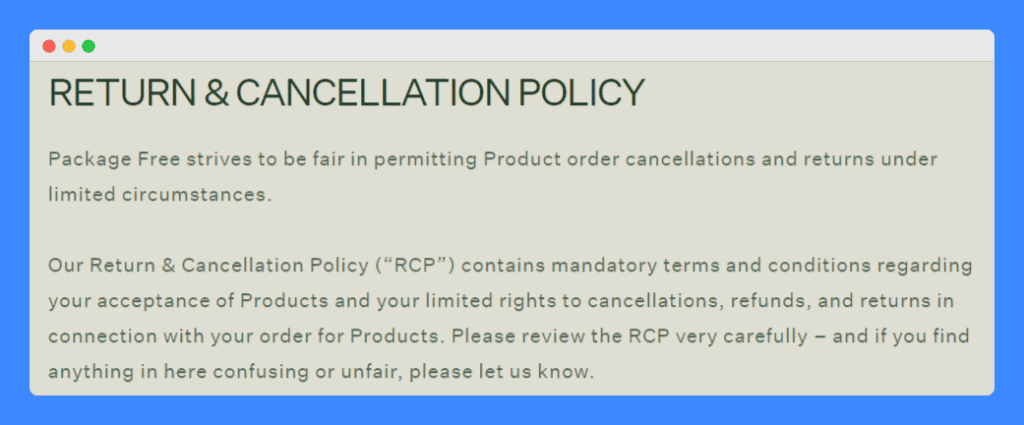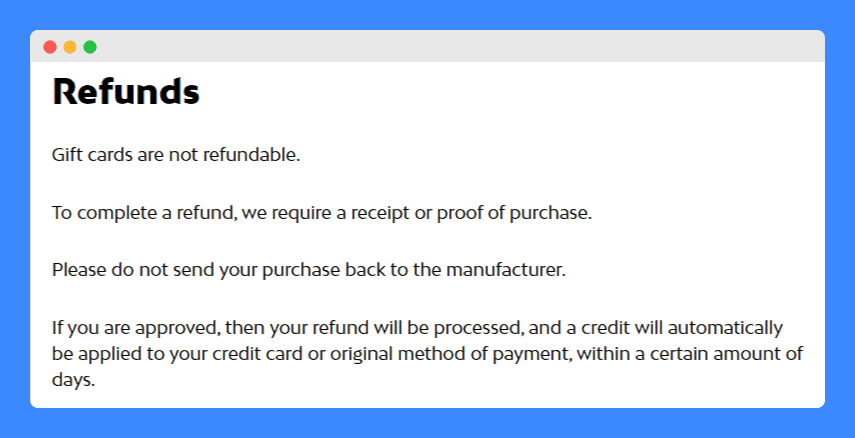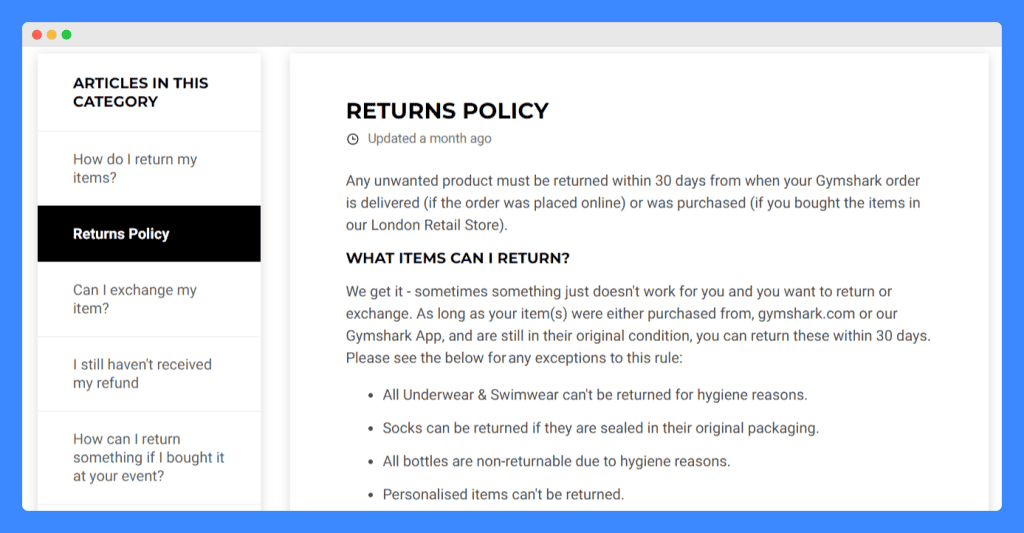If you’ve ever been asked, “What is the refund policy of your store?”, you’re not alone. Every business needs one, not only to ensure a smooth shopping experience but also to attract more sales.
A return and refund policy is a set of rules a store uses to manage returns and refunds. But more than that, it is a crucial aspect of customer service and satisfaction that can significantly impact your business’s reputation and customer loyalty.
For store owners, crafting a transparent and fair policy is essential. It sets clear expectations for your customers and helps protect your business from potential disputes.
So, whether you’re launching a new online shop or running a seasoned brick-and-mortar store, understanding the ins and outs of a return and refund policy is key to aligning customer expectations with your business operations.
- A clear return and refund policy builds trust with customers and reduces confusion. Your policy should outline conditions for returns, refunds, and timelines.
- Your return and refund policy should be easy to find and understand. Use plain language and bullet points, and consider a Q&A format for clarity.
- Regularly review (quarterly) and update your policy (annually) to reflect any changes in regulations or your business practices.
Table of Contents
PRO TIP: Take the hassle of writing your own refund policy away with our refund policy generator trusted by over 200,000 businesses. It’ll save you hours of work and help increase sales in minutes.
What Are the Types of Refund Policy?
Generally, refund policies can be categorized into two types: full refunds and partial refunds. Each type caters to different business scenarios and customer expectations.
Full Refund
A full refund policy means that customers can receive a refund of the total amount paid if they return a defective product or are dissatisfied with their purchase.
For example, a typical policy might state that customers can expect a full refund within 30 days of purchase, provided the item is unopened, unused, and has all tags and packaging intact.
Take a look at Rothy’s returns policy to get an idea of what that sounds like in action:

If a customer receives an item that is defective or damaged upon arrival, they should be entitled to a full refund, including any original shipping costs. This demonstrates your commitment to quality and customer satisfaction.
Partial Refund
Alternatively, a partial refund policy allows customers to receive a refund that is less than the total amount paid. This is common in cases where the returned product is used or damaged by the customer.
Another scenario is when a customer wants to return a product that was originally purchased on sale. In such cases, the store might offer store credit for the current selling price of the item, not the discounted price paid earlier.
Partial refunds might also be offered as store credit, which can be used for future purchases. This approach helps businesses recover costs and encourages customers to continue shopping with them.
PRO TIP: The processing timeframe for refunds varies, but it’s recommended to complete the process within 10 business days from the date you receive the returned item.
Why Do Return and Refund Policy Matter for Your Business?
A clear return and refund policy helps build trust between your business and your customers. It sets expectations for those who may wish to return purchased goods, enhancing the customer experience and potentially boosting customer retention.
It Sets Clear Expectations
Having a defined return and refund policy ensures that both customers and staff understand the procedures for when a customer may return a product. This transparency helps prevent misunderstandings and disputes.
It Boosts Customer Confidence
Customers are more likely to purchase if they know there’s an option for a refund or exchange. This security can lead to increased sales, as the risk of dissatisfaction is minimized.
In fact, a 2022 Statista report states that about 80% of online shoppers in the US mentioned a poor return experience as one of the reasons they avoid repeating purchases from the same retailer. This statistic highlights the direct impact a well-crafted return policy has on repeat business and customer loyalty.
It Enhances Customer Service
A clear return and refund policy helps your customer service team manage returns efficiently. It provides them with a framework to handle requests, which can improve your support team’s overall responsiveness and effectiveness.
It Helps Manage Risks
A return and refund policy can act as a form of risk management, particularly in filtering out fraudulent or abusive return practices. By specifying conditions under which products can be returned, you safeguard your business against potential losses.
It Ensures Legal Compliance
In many regions, businesses are required by law to state how returns and refunds are handled. A well-documented policy ensures compliance with consumer protection laws, avoiding legal issues and potential fines.
A return and refund policy allows customers to experiment with new products without the fear of being stuck with something they don’t like. This can lead to them trying a wider variety of items and potentially spending more overall.
Who Needs a Refund Policy and Why?
Any business that sells goods and services should have a return and refund policy to clearly define how customers can request a refund and under what conditions a refund will be provided. These include:
- Online Retailers: Online businesses especially need clear refund policies because customers cannot physically inspect products before purchase. A policy reassures customers that your store can provide a refund.
- Brick-and-Mortar Stores: Physical stores also benefit from clear refund policies to manage returns efficiently and maintain customer satisfaction, especially in competitive retail environments.
- Service Providers: Any business that offers services, from large corporations to small local businesses, needs a refund policy to clarify terms for cancellations or dissatisfaction with service delivery.
- B2B Companies: Businesses that sell to other businesses must have clear refund policies to address issues like non-delivery, product defects, or contract discrepancies.
- Small Businesses: Even small businesses must have a refund policy to ensure they can handle returns or complaints professionally and legally.
Are Return and Refund Policies Legally Required?
While federal law does not universally require businesses to have one, having a well-written return and refund policy that’s tailored to the needs of your business can be legally necessary depending on your location and the nature of the products or services you sell.
In many cases, whether or not you are required to accept returns is dictated by state or local consumer protection laws.
In the U.S., there is no federal mandate that obligates businesses to accept returns unless the merchandise is defective or the business misrepresented the products.
California, for example, requires stores to post their return policies clearly. If a policy is not clearly posted, the store may be required to accept returns within a minimum period, typically 30 days.
In the EU, consumers have the right to a “cooling-off period” of 14 days during which they can return online purchases without providing any reason. This is part of the consumer protection laws to ensure fairness in transactions made at a distance.
Australian consumer law requires businesses to accept returns if they sold a defective product, failed to deliver on promises, or misled customers. The law also stipulates that products must be of acceptable quality and match the descriptions provided.
Whether return and refund policies are legally required or not varies by location. Know your local laws to ensure legal compliance.
12 Key Components of a Return and Refund Policy
Crafting a return and refund policy for your business isn’t just about ticking regulatory boxes. It’s about connecting with your customers and ensuring they feel secure in their purchases.
Here’s a breakdown of the key components you should include in your policy to ensure it is clear, informative, and protects you and your customers:
1. Overview of the Policy
As the general introduction to your return and refund process, this section sets the tone and helps manage customer expectations right from the start. It should clearly outline the situations in which customers can ask for a refund or exchange for their purchases.
In this return policy example from Package Free, they immediately let the customers know that they accept returns only under limited circumstances. This way, buyers know exactly what to expect if they do decide to buy from this store.

2. Refund Information
Detail the specifics of how customers can receive the refund, including the expected timeframes and the methods of refund (e.g., credit card, store credit).
It’s also important to specify whether the refund will cover the original ticket price or just a portion of it. This will depend on the condition of the returned item and the circumstances of the return.
Blk & Bold, a store that sells coffee, does this effectively in its refund policy. By setting the right expectations, their buyers won’t have to contact them to ask for refund information:

3. Timeline for Refunds
Specify how quickly a refund will be processed once a return is accepted. Clearly state the maximum timeframe within which customers can expect to receive their refund, whether as a cash refund or through the original method of payment.
Businesses should outline if there are any differences in timing between different refund methods. This reassures customers about when they can expect their money back.
For instance, a policy might state that the business will issue a refund within 10 business days from the date of purchase or return acceptance.
4. Condition of Returned Items
This section specifies the state in which goods need to be returned to be eligible for a refund. This includes requirements for the items to be unused, undamaged, and with all original tags and packaging intact.
For instance, Beefcake Swimwear has a strict return policy requiring that all swimwear be returned in its original condition with hygiene stickers in place.

In this return policy sample, this strictness is essential to ensure the products are hygienic and resalable, protecting the business and future customers.
5. Return Process
Outline how to initiate a refund request. This procedure typically involves contacting customer service to submit a refund request and receiving a return merchandise authorization (RMA) number, which must be included with the returned item.
Detailing this process is crucial as it standardizes the return method and ensures all returns are handled efficiently and consistently.
PRO TIP: Communicate any required information they should include with their return shipment, such as a copy of their receipt or a brief explanation for the return.
6. Return Shipping Costs
It’s important to clarify who is responsible for covering the cost of return shipping. Outlining who pays the shipping fee to return an item helps manage customer expectations and avoids any surprises.
There are two main approaches here. You can either absorb the cost or transfer it to the customer. Some businesses, like Allbirds, choose to offer free returns, meaning they cover the cost of shipping the item back.

Alternatively, you can charge customers a flat fee or have them cover the actual return shipping cost.
7. Exchange Policy
Not every customer wants a refund. Some might prefer to exchange an item for a different size, color, or style. If you offer exchanges, clearly outline this policy in this section.
Specify whether customers can return or exchange for a different item of equal or greater value, and if any price difference needs to be settled. Additionally, you might choose to offer exchanges only for unworn and unwashed items with original tags attached, similar to the conditions for returns.
PRO TIP: Consider offering exchanges for store credit to simplify processing. This also encourages customers to spend the credit in your store.
8. Restocking Fees
Your return and refund policy should include information about any restocking fees you might charge for returned items. These fees help cover the cost of processing and restocking returned merchandise.
The decision to implement a restocking fee depends on your business model and product type. In this example, return policy, Silk & Willow, a store selling luxury silk ribbons for weddings, charges a restocking fee.

Since their products are cut to order and customizable, returned ribbons might not be easily resellable. A restocking fee discourages excessive returns and helps recoup some of the processing costs associated with these custom items.
If you do choose to implement a restocking fee, clearly outline the percentage or flat fee and under what circumstances it applies.
9. Non-Returnable Items
This section lists any items that are exempt from your return and refund policy. Whether or not a customer is entitled to a refund depends significantly on these exclusions, which typically include:
- Downloadable Products: Digital products like ebooks, software, or music downloads cannot be returned once purchased and downloaded.
- Personalized Items: Items customized with names, engravings, or other personalized details may not be eligible for returns or exchanges, as they cannot be restocked.
- Gift Cards: Gift cards are typically considered final sale and cannot be returned for cash or refunded.
- Underwear and Swimwear: Due to hygiene concerns, some stores may not accept returns on undergarments and swimwear.
Remember, the items you classify as non-returnable depend on your business and product type. The key is to communicate these exceptions so customers understand whether they are entitled to a refund based on what they purchase.
10. Required Documentation
This section clarifies what documentation customers need to include with their return shipment. Clearly communicate that a refund without the necessary documentation may not be possible to deter fraudulent returns.
In most cases, a copy of the original receipt is ideal for verifying the purchase and processing the refund accurately. If you choose to offer a refund without a receipt, limit the refund amount or offer store credit instead.
11. Contact Information
Provide clear and easily accessible contact information for customer service inquiries regarding returns and refunds. This could include a dedicated email address, phone number, or a live chat option on your website.
In his letter to shareholders in 2016, Jeff Bezos famously said:
“There are many ways to center a business. You can be competitor-focused, you can be product-focused, you can be technology-focused, you can be business model-focused, and there are more. But in my view, obsessive customer focus is by far the most protective of Day 1 vitality.”
By making it easy for customers to reach you with questions or concerns, you demonstrate a commitment to exceptional customer service. This can lead to increased customer satisfaction and loyalty in the long run.
12. Dispute Resolution
Lastly, outline the steps to be followed if disagreements arise over returns or refunds. This is crucial for preemptively managing conflicts and maintaining a positive relationship with your customers.
The policy should detail how disputes will be handled, including the involvement of customer service, the potential for mediation, or the use of formal arbitration if necessary.
A clear, structured approach to resolving conflicts assures customers that their concerns will be handled fairly. This enhances trust and encourages ongoing business interactions.
Best Practices for Creating a Return and Refund Policy
An effective return and refund policy helps enhance customer satisfaction and reduces disputes. But how do you create one? Here are several best practices that can help you make the most of your refund policy:
Make It Easy to Read
Ensure your return and refund policy is straightforward and easy to understand. Use clear, concise language and avoid legal jargon that might confuse customers. Organizing the policy into sections with bold subheadings can also help customers find relevant information quickly.
Display Your Return Policy Prominently
Link to your return policy from your homepage, footer, and during the checkout process. This visibility ensures customers are aware of the terms before they make a purchase, reducing potential dissatisfaction.
Use a Question-and-Answer Format
A question-and-answer format can make your policy more accessible and easier for customers to digest. Gymshark’s Returns Policy is a great example of this approach.

They clearly outline how to process a return by addressing common customer inquiries directly. This makes it easier for customers to find the information they need about how to get a refund.
Update Regularly
Regularly review and update your return and refund policy to ensure it stays relevant to your current operations and complies with any new laws or regulations. This is also a good practice to adapt to any changes in your product lines or customer feedback.
Be Transparent About All Conditions
State all conditions related to returns and refunds, including timelines, required condition of items, and who bears the cost of return shipping. Transparency is key to building trust and managing customer expectations effectively.
Encourage Feedback
Encourage customers to provide feedback on your return process. This can give you valuable insights into how to improve the policy and the overall customer experience.
How To Create a Refund and Return Policy
There are several ways to create a refund and returns policy, but each method has its pros and cons. Choosing the right approach can significantly impact how well your policy serves your business needs and customer expectations.
Hire a Lawyer to Write It
Hiring a lawyer ensures that your standard return and refund policy complies with all legal requirements.
With a lawyer, you get a customized policy that fits your specific business model and legal environment. The problem is that it can be expensive and may require updates as laws change.
Use a Template
Using a return and refund policy template is a quick and cost-effective method. Templates provide a good structure that covers basic scenarios and is easy to adapt.
While they may not account for unique aspects of your business or specific legal nuances, using a template can be more reliable than writing one from scratch and generally more affordable than hiring a lawyer.
Use an Online Policy Generator
Online policy generators, like ours, offer a balance between customization and simplicity. They are designed to incorporate legal requirements specific to your business location and type.
Of course, they might lack the attention to detail of a lawyer-crafted policy. Nonetheless, they are more thorough than most templates and less costly than hiring legal help.
Write It Yourself
Writing a policy yourself using a sample return or refund policy can be the most economical option. It allows for complete control over the content. However, without legal expertise, you risk non-compliance and potential legal issues.
For most businesses, using a template or an online policy generator strikes an excellent balance between compliance, cost, and customization.
Frequently Asked Questions
Are return policies legally binding?
Yes, return policies are legally binding once posted. They form part of the contract between the retailer and the customer.
Can you use a refund policy template?
Yes, you can use a refund policy template. It’s a quick and effective way to ensure your policy covers essential aspects.
Can you copy a refund policy from another website?
No, you should not copy a refund policy from another website. This could lead to legal issues and non-compliance.
Do I need different refund policies for different products or services?
Yes, different products or services may require tailored refund policies. This ensures specific needs and legal requirements are met.
How often should I update my refund policy?
Update your refund policy regularly, at least annually. This keeps it in line with any changes in law or business practices.



